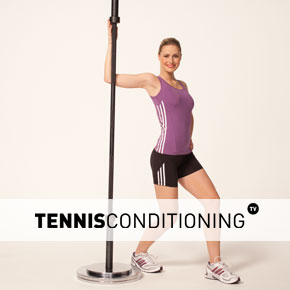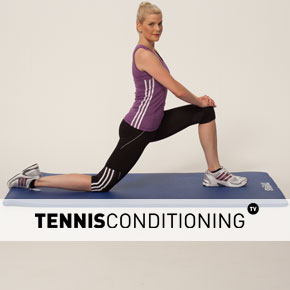Static stretching exercises are mainly being used after the workout or match to reduce muscle soreness the following day.
Another aspect to static stretching is that you can improve overall flexibility or range of motion (ROM) at a particular joint.
Having functional ROM is desirable for efficient body movement and transfer of energy capabilities.
Both is essential for tennis players because you can only perform your best if you are healthy and the more efficient you can transfer energy throughout your body the more powerful your shots will be.
If you want to find out more about transfer of energy find out why core training for tennis players is important.
So why don’t you perform static stretching even before you play tennis?
Why Static Stretching Exercises Are Not Ideal For Warm Ups

Static stretches are not being used as a warm up prior to playing tennis because static stretches can reduce the tension within the muscle tissue, which means that force output is compromised.
In other words, static stretching can negatively impact your explosiveness on the court.
On the other hand, if you feel more comfortable performing static stretching exercises go ahead and do it. It’s still better than simply walking onto the court and hitting balls.
If you are looking for a great tennis warm up then try the 15 perfect warm ups that prepare you for your match.
Other Benefits of Static Stretching
In order to transfer energy the best way your joints should be in sync because structural imbalances negatively impacts transfer of energy capabilities because of “energy leakage” at the joints.
Think of building a house. You want to make sure that the walls are all the same length and height so that the structure is sound and doesn’t collapse when the roof is put on top.
The same holds true for your body where your muscles, tendons, and ligaments hold the bones in place.
If the muscles on your right are less flexible than the muscles on the left then your body is skewed.
Therefore, you can use the following static stretching exercises to improve transfer of energy capabilities and correct for structural imbalances.

Instructions
Hold each stretch for 45 seconds. Click on the static stretch headings if you want more detailed information, such as:
- stretching video
- exercise description
- muscles targeted by the stretch
Arm & Wrist Stretches
Shoulder Stretches
- Anterior deltoid shoulder stretch
- Posterior deltoid stretch
- Pectoralis stretch
- Latissimus dorsi stretch
- Rotator cuff stretch
- Shoulder stretch for internal rotators
Leg Stretches
- Butterfly stretch
- Shin stretch
- Hamstrings and erector spinae stretch
- Quadriceps
- Stretching calves stretch
- Sumo squat stretch






















